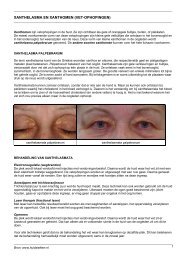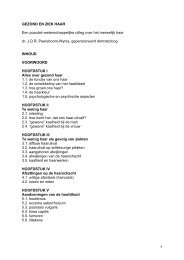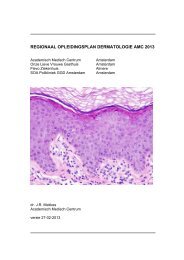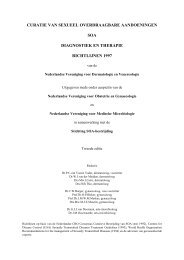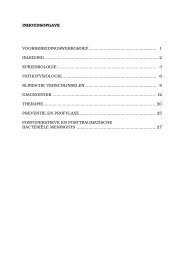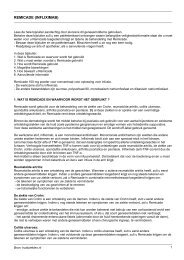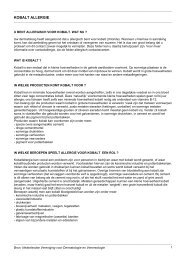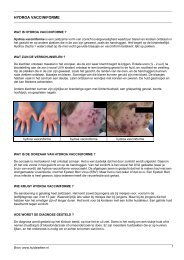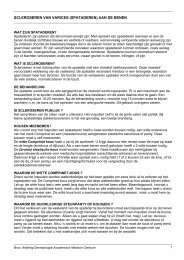Guidelines of care for the management of psoriasis ... - Huidziekten.nl
Guidelines of care for the management of psoriasis ... - Huidziekten.nl
Guidelines of care for the management of psoriasis ... - Huidziekten.nl
You also want an ePaper? Increase the reach of your titles
YUMPU automatically turns print PDFs into web optimized ePapers that Google loves.
860 Gottlieb et al<br />
Table VIII. Recommendations <strong>for</strong> adalimumab<br />
d Indications: moderate/severe psoriatic arthritis;<br />
moderate/severe <strong>psoriasis</strong>; adult and juvenile<br />
rheumatoid arthritis (as young as 4 y); ankylosing<br />
spondylitis; and adult Crohn’s disease<br />
d Dosing: 40 mg every o<strong>the</strong>r wk subcutaneously<br />
d Response: ACR20 at wk 12 is 58%<br />
d Toxicities: see Table VII in Psoriasis <strong>Guidelines</strong> in Section 1<br />
ACR, American College <strong>of</strong> Rheumatology.<br />
inhibitors <strong>for</strong> <strong>the</strong> treatment <strong>of</strong> PsA will be reviewed in<br />
alphabetic order.<br />
Adalimumab efficacy<br />
In a phase III study <strong>of</strong> 313 patients with PsA,<br />
adalimumab showed significant benefit <strong>for</strong> <strong>the</strong> treatment<br />
<strong>of</strong> PsA. 26 Adalimumab was administered subcutaneously<br />
at 40 mg every o<strong>the</strong>r week or weekly. In<br />
<strong>the</strong> double-blinded portion <strong>of</strong> <strong>the</strong> study at 24 weeks,<br />
57% <strong>of</strong> patients receiving adalimumab (40 mg every<br />
o<strong>the</strong>r week) achieved ACR20 response compared<br />
with 15% <strong>of</strong> patients receiving placebo (P \.001). At<br />
week 24, <strong>the</strong> ACR50 and ACR70 response rates were<br />
39% and 23% <strong>for</strong> patients treated with adalimumab<br />
compared with 6% and 1% <strong>for</strong> patients receiving<br />
placebo, respectively (P \ .001). The response rate<br />
did not differ between patients taking adalimumab in<br />
combination with methotrexate (50% <strong>of</strong> patients)<br />
and those taking adalimumab alone, although <strong>the</strong><br />
numbers <strong>of</strong> patients in each cohort were too small to<br />
have adequate statistical power. Mean improvement<br />
in en<strong>the</strong>sitis and dactylitis was greater <strong>for</strong> patients<br />
receiving adalimumab than placebo, but this result<br />
did not achieve statistical significance. Using a modified<br />
Sharp score, radiographic progression <strong>of</strong> hand<br />
and foot joint disease was significantly inhibited by<br />
adalimumab. Mean change in <strong>the</strong> modified Sharp<br />
score was e0.2 <strong>for</strong> patients receiving adalimumab<br />
and 1.0 <strong>for</strong> patients receiving placebo (P \ .001).<br />
Mean change in <strong>the</strong> HAQ was e0.4 <strong>for</strong> patients<br />
taking adalimumab and e0.1 <strong>for</strong> patients taking<br />
placebo (P \.001).<br />
Patients who completed <strong>the</strong> 24-week doubleblind<br />
portion <strong>of</strong> <strong>the</strong> study were eligible to enter an<br />
open-label phase where <strong>the</strong>y received 40 mg <strong>of</strong><br />
adalimumab every o<strong>the</strong>r week <strong>for</strong> ano<strong>the</strong>r 24 weeks.<br />
The ACR20, ACR50, and ACR70 response rates <strong>for</strong><br />
patients who had been on adalimumab <strong>for</strong> 48 weeks<br />
were 56%, 44%, and 30%, respectively. 31<br />
Improvements in disability as measured by <strong>the</strong><br />
HAQ were sustained from week 24 to week 48. At<br />
week 24 and week 48, <strong>the</strong> mean changes from<br />
baseline in <strong>the</strong> modified total Sharp score were<br />
e0.1 and 0.1, respectively, <strong>for</strong> patients who received<br />
Table IX. Recommendations <strong>for</strong> etanercept<br />
d Indications: moderate/severe psoriatic arthritis;<br />
moderate/severe <strong>psoriasis</strong>; adult and juvenile<br />
rheumatoid arthritis (as young as 4 y); and ankylosing<br />
spondylitis<br />
d Dosing <strong>for</strong> psoriatic arthritis: 25 mg twice wk or 50 mg<br />
once wk given subcutaneously<br />
d Response: ACR20 at wk 12 is 59%<br />
d Toxicities: see Table VIII in Psoriasis <strong>Guidelines</strong> in Section 1<br />
d Baseline and ongoing monitoring: see Table VIII in<br />
Psoriasis <strong>Guidelines</strong> in Section 1<br />
ACR, American College <strong>of</strong> Rheumatology.<br />
JAM ACAD DERMATOL<br />
MAY 2008<br />
adalimumab <strong>for</strong> 48 weeks and 0.9 and 1.0, respectively,<br />
<strong>for</strong> patients who received placebo <strong>for</strong> 24<br />
weeks followed by adalimumab <strong>for</strong> 24 weeks.<br />
There was convincing evidence <strong>for</strong> both clinical<br />
and radiographic efficacy <strong>of</strong> adalimumab regardless<br />
<strong>of</strong> whe<strong>the</strong>r patients were or were not taking methotrexate<br />
at baseline. Recommendations <strong>for</strong> adalimumab<br />
are listed in Table VIII.<br />
Etanercept efficacy<br />
In a phase III study <strong>of</strong> 205 patients with PsA,<br />
etanercept showed significant improvement in signs<br />
and symptoms <strong>of</strong> PsA. 27 Etanercept was administered<br />
subcutaneously at 25 mg given twice weekly.<br />
Significant improvement in all outcome measures<br />
was achieved with etanercept treatment, including<br />
<strong>the</strong> number <strong>of</strong> tender joints, number <strong>of</strong> swollen<br />
joints, morning stiffness, C-reactive protein levels,<br />
and both physician and patient global ratings. In this<br />
study, 59% <strong>of</strong> patients taking etanercept as compared<br />
with 15% <strong>of</strong> patients taking placebo achieved an<br />
ACR20 response at 12 weeks (P\.0001). 27 Response<br />
to etanercept was independent <strong>of</strong> concurrent methotrexate<br />
use (46% <strong>of</strong> patients in <strong>the</strong> study were using<br />
concurrent methotrexate at a mean dosage <strong>of</strong> 16<br />
mg/wk), although <strong>the</strong> numbers <strong>of</strong> patients in each<br />
cohort were too small to have adequate statistical<br />
power, similar to observations made in <strong>the</strong> adalimumab<br />
PsA trial. Radiographic disease progression was<br />
inhibited in <strong>the</strong> etanercept group at 12 months; <strong>the</strong><br />
mean annualized rate <strong>of</strong> change in <strong>the</strong> modified total<br />
Sharp score was e0.03 U, compared with 11.00 U in<br />
<strong>the</strong> placebo group (P = .0001). 27 Of <strong>the</strong> 169 patients<br />
who participated in an open-label follow-up use <strong>of</strong><br />
etanercept between 1 and 2 years, <strong>the</strong> modified total<br />
Sharp score in <strong>the</strong> 141 patients evaluated showed a<br />
change <strong>of</strong> e0.38 and e0.22 U in <strong>the</strong> original<br />
etanercept and placebo groups, respectively, indicating<br />
continued inhibition <strong>of</strong> joint structural damage.<br />
32 Recommendations <strong>for</strong> etanercept are listed in<br />
Table IX.



